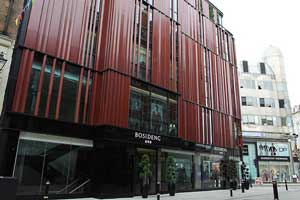
Asia Pacific-based retailers see the greatest potential in their home region, according to a study. All top 10 target destinations for expansion in 2014 are within the region.
Property consultant CBRE says China is a target for 58 per cent of Asia Pacific-based retailers, making it the most sought after market, followed by Vietnam (48 per cent), Malaysia (42 per cent), Indonesia (39 per cent) and Singapore (35 per cent).

“The relatively lower levels of interest by Asia Pacific retailers in expanding in American and European markets reflect a cautious attitude to expanding out of their core markets. That said, we are beginning to see a number of Asia-based brands working on strategies for global markets. “For example, Chinese brand Bosideng opening on Oxford St in London and a number of other Chinese brands are looking to launch in New York and Australia,” said Sebastian Skiff, executive director of CBRE retail.
Retailers’ expansion plans in Asia Pacific are relatively modest, with 29 per cent planning to open less than five stores and a further 26 per cent looking to open between five-10 stores in 2014, CBRE finds. “Most retailers active within Asia Pacific have tended to focus operations within a few countries, and locations are generally limited to the key or top tier cities where quality retail space is accessible. Tougher trading conditions in most markets have tempered expansion ambitions for the short term, however, over the longer term we expect economic growth and the rising middle class in Asia to spur further growth,” said Skiff. It has been found that retailers globally are predominantly targeting countries with mature retail sectors, although a number of emerging markets in Asia Pacific also feature strongly.
Retailers originating from Europe have shown a strong bias towards their own region with less than 15 per cent of retailers targeting markets outside the region. Retailers from the Americas are biased towards the US, but are also targeting European markets, and in particular Germany. China leads the way for Asia Pacific, ranking as the fifth most popular destination for global retailers, with 22 per cent of surveyed retailers targeting the market in 2014. Singapore, Hong Kong, Vietnam, Indonesia and Malaysia also feature in the top 20 target markets worldwide. “China is currently a very exciting place to be as a retailer so it comes as no surprise that China is ranked fifth in retailers’ target markets for 2014.
Globally speaking, the Chinese consumer accounts for a significant proportion of many retailers’ sales, whether they are registering those sales through their stores in China or London, New York, Paris or elsewhere. Having a strong presence in China is an important strategy to drive sales across a brand’s global locations, not just within China itself,” said Skiff.
He said consumer sentiment in China is among the highest in the world and the retail market is expected to expand in 2014 on top of the 23.4 trillion yuan achieved in 2013. “The government has decided to set a target to double household income by 2020; this only adds to the attractiveness of a market that is seeing significant interest from international brands,” added Skiff.
In Vietnam, middle class consumers with rising incomes and a hunger for style continue to draw retailers’ interest. Ho Chi Minh City and Hanoi were both ranked in the top 10 cities of most new retailer entrants in 2012 and 2013, according to CBRE’s Retail Hotspots in Asia Pacific report. The liberation of Foreign Direct Investment (FDI) on wholly-owned retail businesses from 2015 is expected to further stimulate this trend. Meanwhile, the economies of Malaysia and Singapore are strengthening and as a result consumer sentiment is expected to improve in both markets. In Malaysia, an influx of new supply is due over the next few years.
The resulting increase in available space, and expected lower rental levels in these new venues, should provide an added incentive for international retailers wanting to expand there. In Singapore, stability in the economy and the employment market has laid a sound foundation for domestic consumption. Retail spending has also been boosted by the growth in international tourists, especially affluent ones, following the opening of major new visitor attractions. Singapore has since become one of the gateway cities for brands new to Asia. Of some concern though for retailers in Singapore is the availability of qualified sales floor staff. CBRE said retailer appetite has also increased for Indonesia after the recent arrival of major international brands such as Uniqlo and H&M. The Indonesia Shopping Centres Association expects retail sales to grow by 15 per cent in 2014.
www.cbre.com


